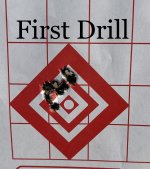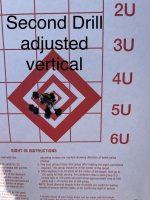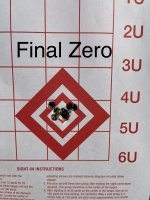So, I’ve been refining my zero method over the last few months. I’ve found that a surprising amount of shooters (myself included in the past) either don’t put enough time/effort into their zero or many times rush and hastily zero their rifle.
There is also the almost always overlooked issue with parallax. A general misconception about parallax is that it has more impact at distance. This would usually be a safe assumption as most everything we deal with is angular which in turn equals a larger linear amount as distance increases. However, parallax is an exception to this. Parallax error will generally be a larger issue at closer distance. You can find more information on this by searching the hide, google, or listening to episode 4 of the Rifles Only Accuracy Podcast.
Armed with the knowledge that parallax is a big deal @ 100yds, that problem is easily solved. Take an extra minute to make sure you are parallax free.
Now, we move onto the issue of effort and time typically not taken by many shooters. The ever talked about “wandering zero” can be many issues, including equipment. However, it’s almost always a shooter error. As noted, parallax is a very big culprit, but we have “solved” that issue already. The next very large factor is shooter consistency. You need to have rock solid, repeatable, and consistent fundamentals. The Hide is a very good resource for fundamentals. Also in person instruction from reputable Instructors such as Frank Galli and Jacob Bynum is also highly encouraged.
So, we have now “fixed” parallax and shooter consistency. We will assume equipment is not the issue (obviously check and fix this if you are having issues). Now we will move onto the real point of this article: time and effort.
I’ve had so many conversations lately about reliable data that I’ve lost count. And there are a few ongoing threads about reliable data in the loading section. In that same spirit, I have found that many shooters not only lack reliable loading data, but they also lack reliable zero data. Many times a “wandering zero” is simply a case of the rifle actually isn’t zero’d perfectly. We are human and therefore are not perfect. Combine that with the inevitable margin of error in our rifle (if you have a .5moa rifle….that means there’s a full .5moa of variability).
Much of the reason this problem exists is a simple matter of not shooting enough rounds to really hammer in your zero. So, for me there are two options. 1: continually tweak your zero each range trip (I’m talking a tenth here and there) until it’s rock solid or 2: take the time in a single range session to perfect your zero.
Option 1 doesn’t really work for me. I take my rifle apart and remove the barrel to clean every 2-300 rounds (you should be keeping your barrel clean, but that’s another conversation). So, my zero may be slightly off when everything is reassembled.
So, option 2 it is. However, I find it very boring laying on my stomach or standing behind a bench for more than a few rounds. This gives us the perfect opportunity to tackle another issue many shooters have: productive practice. So, I have developed a two bird one stone approach that has been working extremely well for me. I perfect/tune my zero while getting in a very productive practice session.
I have long advocated for shooting paper @ 100yds as a shooter’s primary practice. People such as Chris Way have developed similar approaches (check out RifleKraft). So, this is how I now hammer in my zero and practice and the same time:
1: set up paper targets at 100yds. I usually have four targets (1 for rough zero and 3 for practice/fine tune). I use either the 3” circles which have a 1” center circle or I use 1” circles. Either way, your goal target is a 1moa circle (1” is close enough for 100yds over an actual 1.047”).
2: either prone or standing behind a bench get a rough zero on one of the targets.. Within an MOA or so of the center of your desired target.
3: round count is up to you. Use at least 10 rounds per “drill” or target. I like using 20 rounds for a 60 round practice. But 30 is also fine and a good practice session.
4: every single shot now will be from standing, kneeling, or sitting (can add prone if you like). Off a stable barricade (or whatever prop, but needs to be stable) and a single bag. The point is to shoot this exactly like you would shoot positional shots at a match. With the same amount of recoil management that you use on average. Most of us will be utilizing some form of “free recoil” in the sense we won’t be fully loaded into the rifle. That part is up to you.
5: every single shot will be some sort of build and break. I suggest either not using a timer or using a time you can comfortably make perfect shots with. Remember, we are also using this to zero the rifle, so we don’t want to be sending off errant shots.
6: perform the first 10 (or however many you choose) build and break drills on one of the targets. Do not chase your impacts. Keep the same POA and focus on perfect positions and shots. You can still assess your performance based on the group size and still get great practice positionally.
7: look at the center of your group and pick *one* factor to adjust. Vertical or horizontal. Make the adjustments in your turrets.
8: perform another full build and break drill. Your group should now be as centered up as possible on the vertical or horizontal plane depending which you chose to adjust. Now adjust the remaining horizontal or vertical plane that you didn’t adjust last time.
9: perform your last build and break drill. Your group should now basically be punching a hole out of the 1” circle. It may be a little larger than an moa depending on your current ability. I typically see around .7-.8 moa for 20 shots and I’m extremely happy with that.
Now, you have just completed a practice session with 30-60 different built and break drills as well as verifying you zero through 30-60 rounds. It should also have your rifle zero from the positions you will be using the most at a match (usually 20% or less is prone). Technically you shouldn’t have much if any POI change from prone to positional, but many shooters do.
I have been using this method for several months now and feel it gives me a far superior zero than most of us usually get as well as having an awesome and productive practice session. I usually do this a day or two before a match. I save the harder/shorter time practice for weeks leading up to a match and take it easy on practice a day or two before a match. You won’t gain anything else from short time practice the day before a match as that training/work should have already been done. A rock solid zero and confidence building simple build and break drills will do far more for you in the days before a match.
I will post three picks below which show you the progression of this drill.
Let me know if you have any questions or if this works for you after you try it.
Thanks
There is also the almost always overlooked issue with parallax. A general misconception about parallax is that it has more impact at distance. This would usually be a safe assumption as most everything we deal with is angular which in turn equals a larger linear amount as distance increases. However, parallax is an exception to this. Parallax error will generally be a larger issue at closer distance. You can find more information on this by searching the hide, google, or listening to episode 4 of the Rifles Only Accuracy Podcast.
Armed with the knowledge that parallax is a big deal @ 100yds, that problem is easily solved. Take an extra minute to make sure you are parallax free.
Now, we move onto the issue of effort and time typically not taken by many shooters. The ever talked about “wandering zero” can be many issues, including equipment. However, it’s almost always a shooter error. As noted, parallax is a very big culprit, but we have “solved” that issue already. The next very large factor is shooter consistency. You need to have rock solid, repeatable, and consistent fundamentals. The Hide is a very good resource for fundamentals. Also in person instruction from reputable Instructors such as Frank Galli and Jacob Bynum is also highly encouraged.
So, we have now “fixed” parallax and shooter consistency. We will assume equipment is not the issue (obviously check and fix this if you are having issues). Now we will move onto the real point of this article: time and effort.
I’ve had so many conversations lately about reliable data that I’ve lost count. And there are a few ongoing threads about reliable data in the loading section. In that same spirit, I have found that many shooters not only lack reliable loading data, but they also lack reliable zero data. Many times a “wandering zero” is simply a case of the rifle actually isn’t zero’d perfectly. We are human and therefore are not perfect. Combine that with the inevitable margin of error in our rifle (if you have a .5moa rifle….that means there’s a full .5moa of variability).
Much of the reason this problem exists is a simple matter of not shooting enough rounds to really hammer in your zero. So, for me there are two options. 1: continually tweak your zero each range trip (I’m talking a tenth here and there) until it’s rock solid or 2: take the time in a single range session to perfect your zero.
Option 1 doesn’t really work for me. I take my rifle apart and remove the barrel to clean every 2-300 rounds (you should be keeping your barrel clean, but that’s another conversation). So, my zero may be slightly off when everything is reassembled.
So, option 2 it is. However, I find it very boring laying on my stomach or standing behind a bench for more than a few rounds. This gives us the perfect opportunity to tackle another issue many shooters have: productive practice. So, I have developed a two bird one stone approach that has been working extremely well for me. I perfect/tune my zero while getting in a very productive practice session.
I have long advocated for shooting paper @ 100yds as a shooter’s primary practice. People such as Chris Way have developed similar approaches (check out RifleKraft). So, this is how I now hammer in my zero and practice and the same time:
1: set up paper targets at 100yds. I usually have four targets (1 for rough zero and 3 for practice/fine tune). I use either the 3” circles which have a 1” center circle or I use 1” circles. Either way, your goal target is a 1moa circle (1” is close enough for 100yds over an actual 1.047”).
2: either prone or standing behind a bench get a rough zero on one of the targets.. Within an MOA or so of the center of your desired target.
3: round count is up to you. Use at least 10 rounds per “drill” or target. I like using 20 rounds for a 60 round practice. But 30 is also fine and a good practice session.
4: every single shot now will be from standing, kneeling, or sitting (can add prone if you like). Off a stable barricade (or whatever prop, but needs to be stable) and a single bag. The point is to shoot this exactly like you would shoot positional shots at a match. With the same amount of recoil management that you use on average. Most of us will be utilizing some form of “free recoil” in the sense we won’t be fully loaded into the rifle. That part is up to you.
5: every single shot will be some sort of build and break. I suggest either not using a timer or using a time you can comfortably make perfect shots with. Remember, we are also using this to zero the rifle, so we don’t want to be sending off errant shots.
6: perform the first 10 (or however many you choose) build and break drills on one of the targets. Do not chase your impacts. Keep the same POA and focus on perfect positions and shots. You can still assess your performance based on the group size and still get great practice positionally.
7: look at the center of your group and pick *one* factor to adjust. Vertical or horizontal. Make the adjustments in your turrets.
8: perform another full build and break drill. Your group should now be as centered up as possible on the vertical or horizontal plane depending which you chose to adjust. Now adjust the remaining horizontal or vertical plane that you didn’t adjust last time.
9: perform your last build and break drill. Your group should now basically be punching a hole out of the 1” circle. It may be a little larger than an moa depending on your current ability. I typically see around .7-.8 moa for 20 shots and I’m extremely happy with that.
Now, you have just completed a practice session with 30-60 different built and break drills as well as verifying you zero through 30-60 rounds. It should also have your rifle zero from the positions you will be using the most at a match (usually 20% or less is prone). Technically you shouldn’t have much if any POI change from prone to positional, but many shooters do.
I have been using this method for several months now and feel it gives me a far superior zero than most of us usually get as well as having an awesome and productive practice session. I usually do this a day or two before a match. I save the harder/shorter time practice for weeks leading up to a match and take it easy on practice a day or two before a match. You won’t gain anything else from short time practice the day before a match as that training/work should have already been done. A rock solid zero and confidence building simple build and break drills will do far more for you in the days before a match.
I will post three picks below which show you the progression of this drill.
Let me know if you have any questions or if this works for you after you try it.
Thanks





